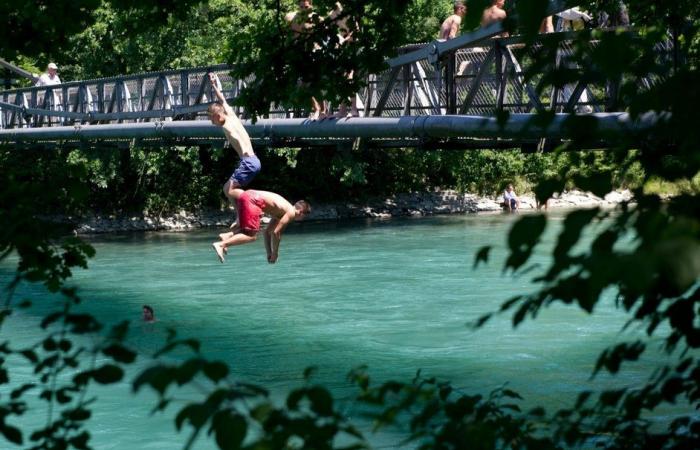Content reserved for subscribers
Staged on social networks, dizzying bridge jumps cause multiple injuries, as recently at the Pont de la Jonction in Geneva.
Jumps from bridges made without knowledge of the depth of the water at impact are very dangerous, even if the height is not dizzying. © Keystone
Published on 06/24/2024
Estimated reading time: 7 minutes
“Seriously injured”: such is the worrying situation of the 20-year-old young man who on June 7 in Geneva plunged 28 meters from the Jonction viaduct, overlooking the Rhône and the Arve, at the place where the two rivers join. The diver landed poorly.
This type of “feat” has a name: bridge jumping. It is one of these “extreme challenges”, increasingly popular with young people looking for thrills and visibility on their TikTok, Instagram or other YouTube channels. Having become a fashion phenomenon, bridge jumping is enough to alert the authorities.
“The Geneva police wish to raise awareness among the population not to carry out this type of dangerous practice, often exposed on social networks with a spirit of emulation,” she recently released in a press release. Not only is jumping or diving from bridges prohibited, but this practice carries the risk of serious or even fatal injury – as does “wild” swimming outside authorized and safe areas (read box).
Contact us
Note that Geneva does not have a monopoly on this risky practice. 16 meters high, the Corbières bridge represents another popular spot for years. In August 2011, three incidents followed, with a transfer to hospital for broken vertebrae. In the canton of Fribourg, the means of limiting this type of activity are very limited.
“This practice is not prohibited. The Bridges and Roads Department, however, draws attention to the dangers associated with it and emphasizes that it is illusory to want to secure all the bridges. It is important to know that people who take the risk of jumping do so under their own responsibility,” warns Christa Bielmann, spokesperson for the Friborg cantonal police. She continues: “The police are warning the population against the dangers of these practices.”
“The popularization of bridge jumping is clearly linked to its filmed staging and its distribution on social networks”
Nicolas Millot
The overall figures for 2023 appear less alarming than elsewhere – 20 interventions by the lake police “for people, navigators, paddlers or kitesurfers in difficulty, and 7 for the 3 mandated cantonal rescue companies (Estayer-le-Lac – Delley-Portalban-Gletterens – Vully).
Not to imitate
However, the approach of summer and extreme heat calls for increased prevention. But where does this bridge jumping fashion come from? “It’s a practice that we have known for 4 or 5 years,” observes First Lieutenant Nicolas Millot, communications officer within the Fire and Rescue Service (SIS) in Geneva. It would firstly be the work of very trained young athletes, who carry out all the work of physical preparation and location scouting beforehand.
However, even with prior training, accidents are always to be deplored. In just two years, the SIS has counted around ten cases and “several injured”. “The popularization of bridge jumping is clearly linked to its filmed staging and its distribution on social networks.
So much so that certain spots have become unmissable, known even from abroad: “The Jonction bridge, above all, but also the gallery under the Butin bridge (more than 36 meters high, editor’s note), where young people found access.” The concern of the rescuers who must intervene also concerns the intrepid young people who have neither preparation nor knowledge of the area. “We are witnessing an imitation of what is circulating on social networks, especially over the last two or three years. We can say that we are experiencing our third summer season here…”
Multiple hazards
In addition, a river like the Rhône presents multiple dangers. Nicolas Millot: “Under the Jonction bridge, the flow varies greatly, from 100 to 500 cubic meters per second, due to the Seujet dam (located upstream, editor’s note). And therefore also, the depth of the water, with the risk that the diver is missing one or two meters to break his fall and that he hits the bottom. In summer 2023, the head of SIS had already had to intervene. He witnessed such scenes several times: patiently filmed by the diver’s associates who had neither the equipment nor the skills to help.
Videos showing dizzying bridge jumps showcase the fun side of these “exploits” without revealing the dark side. This is why the SIS posted other images on their Instagram account highlighting the risks involved. This prevention is all the more important as bridge jumping practices have spread, but to a lesser extent, “to the cities of Fribourg, Bern and Basel”, underlines the manager.
Will the SIS Instagram account get enough views? His images are much more informative than the first sensational bridge jumping videos that appeared around fifteen years ago on YouTube, posted by divers in the United States and quickly became a source of concern for American rescuers.
In Switzerland, one of the oldest YouTube videos, entitled Bridge jumping in Geneva, was posted 11 years ago already. It begins with a sequence on the Sous-Terre bridge, with a close-up of the “no diving” sign. It was broadcast by a young French-speaking Swiss videographer who has since multiplied the likes. He now sells his services as an influencer and communications advisor.
Entering the water at 85 km/h
Sunday June 16, a new tragedy occurred in the Rhône, still in Geneva and in the perimeter of the Jonction bridge: the river carried away a person, seen in difficulty, in the afternoon. Despite the rapid deployment of a major intervention system – ground team, divers, helicopter, Navigation Brigade boat, land patrol, etc., more than 25 rescuers – the searches remained in vain. SIS rescuers carry out 30 to 40 interventions in aquatic environments per year in Geneva, half of which for the Rhône.
Last year, at the same time in June, Geneva had up to five drownings in just a few days. The canton has become the one with the most cases, out of the 36 drownings recorded until the end of August 2023 by the Swiss Rescue Society (SSS).
With the intense summer heat, the year 2022 presented one of the worst results in almost 20 years: 63 deaths. “The annual drowning statistics from the SSS show the scale of accidents, the places where they occur and the people affected,” specifies the Swiss Rescue Society, based in Sursee (Lucerne).
Contrary to what one might imagine, the first victims of drowning are by far not children (less than 10% of cases), but men — and especially in the 15 to 30 year old age group. Depending on the year, there are more drownings in Switzerland’s rivers than in lakes.
It is difficult to know what proportion of accidents and drownings are directly linked to jumps and dives from bridges, even if it is certain that the practice of bridge jumping increases the dangers. Jumping from such a height means reaching 85 km/h at the moment of impact on the water surface. Even in the event of a “perfect dive” upon landing, there are numerous risks of serious trauma: fractures or spinal trauma, paralysis, lesions or hemorrhages on internal organs, concussion, etc.
The victims are mainly men aged 15 to 30.
Poor estimation of depth, presence of hidden obstacles, strong temperature differences between the ambient air and the aquatic environment, between the waters of the Rhône and those of the Arve (up to more than 15 degrees), risks of hydrocution are among the major dangers.
Not forgetting the submerged tree branches and roots which trap many swimmers every year, unable to free themselves due to the current. The latter is often fatal. In August 2020, a 21-year-old young man did not survive his dive from the Seujet dam, which controls the level of Lake Geneva and presents strong turbulence.







